*NURSING > QUESTIONS & ANSWERS > NSG 6020 Week 8 Study Guide (complete0 questions and answers- 2020. (All)
NSG 6020 Week 8 Study Guide (complete0 questions and answers- 2020.
Document Content and Description Below
NSG 6020 Week 8 Study Guide Chapter 12. Male Reproductive System Multiple Choice Identify the choice that best completes the statement or answers the question. ____ 1. Examination of the male ... patient is best done in a warm room in order to avoid: A. Exaggeration of the cremasteric reflex B. Discomfort during digital rectal exam (DRE) C. Retraction of the testes into the abdomen D. Concealment of an inguinal hernia ____ 2. A 12-year-old boy accompanied by his mother reports sudden severe pain in the right lower abdomen and scrotum. There is no history of trauma. Upon physical examination, the right scrotum is extremely tender to touch. These are signs of: A. Fournier’s disease B. Testicular cancer C. Testicular torsion D. Varicocele of the testes ____ 3. Which of the following is a risk factor for testicular cancer? A. Fournier’s disease B. Testicular torsion C. Varicocele of the testes D. Cryptorchidism ____ 4. A 22-year-old male patient recently noticed swelling of the right testicle. He reports a feeling of heaviness and a dull ache in the testicle. There is no history of recent trauma. Physical examination reveals enlargement of the affected testicle, which is firm. The right scrotum is erythematous, and inguinal lymph nodes are palpable. It is important to recognize these are signs and symptoms of: A. Varicocele of the testes B. Testicular cancer C. Hematocele of the testes D. Torsion of the testes ____ 5. A 35-year-old male patient recently noticed a nodular growth on the right testicle. He reports a feeling of pain and heaviness in the testicle. Physical examination reveals a smooth, firm nodule of 5 to 6 cm on the right testicle. The right scrotum is erythematous, and inguinal lymph nodes are palpable. The clinician should order a(n) ____ to evaluate this finding. A. Ultrasound of the scrotum B. CT scan of the pelvis C. Pelvic x-ray D. Digital rectal exam ____ 6. Which of the following is a biochemical marker for testicular cancer? A. Carcinogenic antigen 125 (CA-125) B. Alpha-fetoprotein (AFP) C. Carcinoembryonic antigen (CEA) D. Tumor necrosis factor (TNF) ____ 7. In heterosexual men, the most common cause of epididymitis is (are): A. E. coli B. Neisseria gonorrhoeae C. Chlamydia trachomatis D. B & C ____ 8. A 26-year-old male admits to unprotected sexual activity with men. He complains of pain in the left scrotal region and burning on urination that started 2 days ago. The scrotum is swollen and tender to palpation. A urethral discharge is evident. Pain decreases with elevation of the left scrotum. There is no pain on DRE. These are signs of: A. Testicular torsion B. Testicular cancer C. Epididymitis D. Prostatitis ____ 9. A 7-year-old male presents with fever and swollen parotid glands. He is diagnosed with mumps. A complication that can occur with mumps in a male patient is: A. Orchitis B. Prostatitis C. Testicular torsion D. Varicocele ____ 10. In order for the clinician to diagnose a varicocele, the patient needs to: A. Lie in the left lateral recumbent position B. Stand and bear down C. Lean over for digital rectal exam D. Lie in the supine position ____ 11. Which of the following male reproductive disorders resembles a “bag of worms” on inspection? A. Spermatocele B. Hydrocele C. Varicocele D. None of the above ____ 12. Which of the following is considered a risk factor for penile cancer? A. Chlamydia infection B. Condyloma acuminata C. Epispadius D. Circumcision ____ 13. Which of the following most commonly causes balanitis? A. Tinea B. Syphilis C. Candida D. Gonorrhoea ____ 14. Balanitis Xerotica Obliterans (BXO) is painful condition most common in: A. Adolescent males B. Young adult males C. Middle-aged males D. Males less than 10 years old ____ 15. The condition of the penis termed “phimosis” is: A. Difficulty separating the foreskin from the penis B. Curvature of the penis when erect C. Inability of the penis to attain erection D. Inability of detumescence of the penis ____ 16. Which of the following conditions is considered a urologic emergency? A. Balanitis B. Paraphimosis C. Phimosis D. None of the above ____ 17. The majority of male newborns born with cryptorchidism usually attain testicular descent by: A. 1 week old B. 1 month old C. 6 months old D. 1 year old ____ 18. In Klinefelter’s syndrome, males commonly have: A. Gynecomastia B. Undeveloped testes C. Tall height D. All of the above ____ 19. Which of the following is the genetic makeup of a male with Klinefelter’s syndrome? A. 46 XX B. 47 XXY C. 47 XYY D. 45 XXY ____ 20. The most common cause of erectile dysfunction (ED) is: A. Peripheral neuropathy B. Low testosterone C. Peripheral vascular disease D. Autonomic neuropathy ____ 21. Priapism often occurs in male patients with: A. Sickle cell anemia B. Low testosterone C. Diabetes mellitus D. Autonomic neuropathy ____ 22. Peyronie’s disease in the male causes: A. Balanitis of the penis B. Cryptorchidism C. Curvature of the penis D. Fracture of the penis ____ 23. Your male patient is 456 pounds and complains of erectile dysfunction. On physical examination, you note gynecomastia, decreased pubic, facial, and axillary hair, as well as atrophic testes. This is due to: A. Vascular disease that affects the testes B. Conversion of testosterone in fatty tissue to estradiol C. Androgen resistance of fatty tissue D. All of the above ____ 24. A male and female patient complain of problems with conception. The female patient is in generally good health. The male patient reports history of cystic fibrosis. It is important for the clinician to recognize that in male patients with CF, there is often malformation of the: A. Vas deferens B. Epididymis C. Seminal vesicles D. All of the above ____ 25. A male and female patient complain of problems with conception. The female patient is in generally good health. The male patient is a body builder who admits to anabolic steroid use. It is important for the clinician to recognize that in male steroid users, there is often: A. Atrophic testes B. Excessive natural testosterone C. Inadequate natural testosterone D. A & C Bates’ Guide to Physical Examination and History Taking, 12th Edition Chapter 13 Male Genitalia and Hernias 1. A 28-year-old musician comes to your clinic, complaining of a “spot” on his penis. He states his partner noticed it 2 days ago and it hasn't gone away. He says it doesn't hurt. He has had no burning with urination and no pain during intercourse. He has had several partners in the last year and uses condoms occasionally. His past medical history consists of nongonococcal urethritis from Chlamydia and prostatitis. He denies any surgeries. He smokes two packs of cigarettes a day, drinks a case of beer a week, and smokes marijuana and occasionally crack. He has injected IV drugs before but not in the last few years. He is single and currently unemployed. His mother has rheumatoid arthritis and he doesn't know anything about his father. On examination you see a young man appearing deconditioned but pleasant. His vital signs are unremarkable. On visualization of his penis there is a 6-mm red, oval ulcer with an indurated base just proximal to the corona. There is no prepuce because of neonatal circumcision. On palpation the ulcer is nontender. In the inguinal region there is nontender lymphadenopathy. What disorder of the penis is most likely the diagnosis? A) Condylomata acuminata B) Genital herpes C) Syphilitic chancre D) Penile carcinoma 2. A 20-year-old part-time college student comes to your clinic, complaining of growths on his penile shaft. They have been there for about 6 weeks and haven't gone away. In fact, he thinks there may be more now. He denies any pain with intercourse or urination. He has had three former partners and has been with his current girlfriend for 6 months. He says that because she is on the pill they don't use condoms. He denies any fever, weight loss, or night sweats. His past medical history is unremarkable. In addition to college, he works part-time for his father in construction. He is engaged to be married and has no children. His father is healthy and his mother has hypothyroidism. On examination the young man appears healthy. His vital signs are unremarkable. On visualization of his penis you see several moist papules along all sides of his penile shaft and even two on the corona. He has been circumcised. On palpation of his inguinal region there is no inguinal lymphadenopathy. Which abnormality of the penis does this patient most likely have? A) Condylomata acuminata B) Genital herpes C) Syphilitic chancre D) Penile carcinoma 3. A 29-year-old married computer programmer comes to your clinic, complaining of “something strange” going on in his scrotum. Last month while he was doing his testicular self-examination he felt a lump in his left testis. He waited a month and felt the area again, but the lump was still there. He has had some aching in his left testis but denies any pain with urination or sexual intercourse. He denies any fever, malaise, or night sweats. His past medical history consists of groin surgery when he was a baby and a tonsillectomy as a teenager. He eats a healthy diet and works out at the gym five times a week. He denies any tobacco or illegal drugs and drinks alcohol occasionally. His parents are both healthy. On examination you see a muscular, healthy, young-appearing man with unremarkable vital signs. On visualization the penis is circumcised with no lesions; there is a scar in his right inguinal region. There is no lymphadenopathy. Palpation of his scrotum is unremarkable on the right but indicates a large mass on the left. Placing a finger through the inguinal ring on the right, you have the patient bear down. Nothing is felt. You attempt to place your finger through the left inguinal ring but cannot get above the mass. On rectal examination his prostate is unremarkable. What disorder of the testes is most likely the diagnosis? A) Hydrocele B) Scrotal hernia C) Scrotal edema D) Varicocele 4. A 32-year-old white male comes to your clinic, complaining of aching on the right side of his testicle. He has felt this aching for several months. He states that as the day progresses the aching increases, but when he wakes up in the morning he is pain-free. He denies any pain with urination and states that the pain doesn't change with sexual activity. He denies any fatigue, weight gain, weight loss, fever, or night sweats. His past medical history is unremarkable. He is a married hospital administrator with two children. He notes that he and his wife have been trying to have another baby this year but have so far been unsuccessful despite frequent intercourse. He denies using tobacco, alcohol, or illegal drugs. His father has high blood pressure but his mother is healthy. On examination you see a young man appearing his stated age with unremarkable vital signs. On visualization of his penis, he is circumcised with no lesions. He has no scars along his inguinal area, and palpation of the area shows no lymphadenopathy. On palpation of his scrotum you feel testes with no discrete masses. Upon placing your finger through the right inguinal ring you feel what seems like a bunch of spaghetti. Asking him to bear down, you feel no bulges. The left inguinal ring is unremarkable, with no bulges on bearing down. His prostate examination is unremarkable. What abnormality of the scrotum does he most likely have? A) Hydrocele B) Scrotal hernia C) Scrotal edema D) Varicocele 5. A 48-year-old policeman comes to your clinic, complaining of a swollen scrotum. He states it began a couple of weeks ago and has steadily worsened. He says the longer he stands up the worse it gets, but when he lies down it improves. He denies any pain with urination. Because heis impotent he doesn't know if intercourse would hurt. He states he has become more tired lately and has also gained 10 pounds in the last month. He denies any fever or weight loss. He has had some shortness of breath with exertion. His past medical history consists of type 2 diabetes for 20 years, high blood pressure, and coronary artery disease. He is on insulin, three high blood pressure pills, and a water pill. He has had his gallbladder removed. He is married and has five children. He is currently on disability because of his health problems. Both of his parents died of complications of diabetes. On examination you see a pleasant male appearing chronically ill. He is afebrile but his blood pressure is 160/100 and his pulse is 90. His head, eyes, ears, nose, throat, and neck examinations are normal. There are some crackles in the bases of each lung. During his cardiac examination there is an extra heart sound. Visualization of his penis shows an uncircumcised prepuce but no lesions or masses. Palpation of his scrotum shows generalized swelling, with no discrete masses. A gloved finger is placed through each inguinal ring, and with bearing down there are no bulges. The prostate is smooth and nontender. What abnormality of the scrotum is most likely the diagnosis? A) Hydrocele B) Scrotal hernia C) Scrotal edema D) Varicocele 6. A 36-year-old security officer comes to your clinic, complaining of a painless mass in his scrotum. He found it 3 days ago during a testicular self-examination. He has had no burning with urination and no pain during sexual intercourse. He denies any weight loss, weight gain, fever, or night sweats. His past medical history is notable for high blood pressure. He is married and has three healthy children. He denies using illegal drugs, smokes two to three cigars a week, and drinks six to eight alcoholic beverages per week. His mother is in good health and his father had high blood pressure and coronary artery disease. On physical examination he appears anxious but in no pain. His vital signs are unremarkable. On visualization of his penis, he is circumcised and has no lesions. His inguinal region has no lymphadenopathy. Palpation of his scrotum shows a soft cystic-like lesion measuring 2 cm over his right testicle. There is no difficulty getting a gloved finger through either inguinal ring. With weight bearing there are no bulges. His prostate examination is unremarkable. What disorder of the scrotum does he most likely have? A) Hydrocele B) Scrotal hernia C) Testicular tumor D) Varicocele 7. A 22-year-old unemployed roofer presents to your clinic, complaining of pain in his testicle and penis. He states the pain began last night and has steadily become worse. He states it hurts when he urinates and he has not attempted intercourse since the pain began. He has tried Tylenol and ibuprofen without improvement. He denies any fever or night sweats. His past medical history is unremarkable. He has had four previous sexual partners and has had a new partner for the last month. She is on oral contraceptives so he has not used condoms. His parents are both in good health. On examination you see a young man lying on his side. He appears mildly ill. His temperature is 100.2 and his blood pressure, respirations, and pulse are normal. On visualization of the penis he is circumcised, with no lesions or discharge from the meatus. Visualization of the scrotal skin appears unremarkable. Palpation of the testes shows severe tenderness at the superior pole of the normal-sized left testicle. He also has tenderness when you palpate the structures superior to the testicle through the scrotal wall. The right testicle is unremarkable. An examining finger is placed through each inguinal ring without bulges being noted with bearing down. His prostate examination is unremarkable. Urine analysis shows white blood cells and bacteria. What diagnosis of the male genitalia is most likely in this case? A) Acute orchitis B) Acute epididymitis C) Torsion of the spermatic cord D) Prostatitis 8. A 15-year-old high school football player is brought to your office by his mother. He is complaining of severe testicular pain since exactly 8:00 this morning. He denies any sexual activity and states that he hurts so bad he can't even urinate. He is nauseated and is throwing up. He denies any recent illness or fever. His past medical history is unremarkable. He denies any tobacco, alcohol, or drug use. His parents are both in good health. On examination you see a young teenager lying on the bed with an emesis basin. He is very uncomfortable and keeps shifting his position. His blood pressure is 150/100, his pulse is 110, and his respirations are 24. On visualization of the penis he is circumcised and there are no lesions and no discharge from the meatus. His scrotal skin is tense and red. Palpation of the left testicle causes severe pain and the patient begins to cry. His prostate examination is unremarkable. His cremasteric reflex is absent on the left but is normal on the right. By catheter you get a urine sample and the analysis is unremarkable. You send the boy with his mother to the emergency room for further workup. What is the most likely diagnosis for this young man's symptoms? A) Acute orchitis B) Acute epididymitis C) Torsion of the spermatic cord D) Prostatitis 9. A 16-year-old high school junior is brought to your clinic by his father. The teenager was taught in his health class at school to do monthly testicular self-examinations. Yesterday when he felt his left testicle it was enlarged and tender. He isn't sure if he has had burning with urination and he says he has never had sexual intercourse. He has had a sore throat, cough, and runny nose for the last 3 days. His past medical history is significant for a tonsillectomy as a small child. His father has high blood pressure and his mother is healthy. On examination you see a teenager in no acute distress. His temperature is 100.8 and his blood pressure and pulse are unremarkable. On visualization of his penis, he is uncircumcised and has no lesions or discharge. His scrotum is red and tense on the left and normal appearing on the right. Palpating his left testicle reveals a mildly sore swollen testicle. The right testicle is unremarkable. An examining finger is put through both inguinal rings, and there are no bulges with bearing down. His prostate examination is unremarkable. Urine analysis is also unremarkable. What abnormality of the testes does this teenager most likely have? A) Acute orchitis B) Acute epididymitis C) Torsion of the spermatic cord D) Prostatitis 10. A 45-year-old electrical engineer presents to your clinic, complaining of spots on his scrotum. He first noticed the spots several months ago, and they have gotten bigger. He denies any pain with urination or with sexual intercourse. He has had no fever, night sweats, weight gain, or weight loss. His past medical history consists of a vasectomy 10 years ago and mild obesity. He is on medication for hyperlipidemia. He denies any tobacco or illegal drug use and drinks alcohol socially. His mother has Alzheimer's disease and his father died of leukemia. On examination he appears relaxed and has unremarkable vital signs. On visualization of his penis, he is circumcised and has no lesions on his penis. Visualization of his scrotum shows three yellow nodules 2–3 millimeters in diameter. During palpation they are firm and nontender. What abnormality of the male genitalia is this most likely to be? A) Condylomata acuminata B) Syphilitic chancre C) Peyronie's disease D) Epidermoid cysts 11. Jim is a 47-year-old man who is having difficulties with sexual function. He is recently separated from his wife of 20 years. He notes that he has early morning erections but otherwise cannot function. Which of the following is a likely cause for his problem? A) Decreased testosterone levels B) Psychological issues C) Abnormal hypogastric arterial circulation D) Impaired neural innervation 12. Which of the following conditions involves a tight prepuce which, once retracted, cannot be returned? A) Phimosis B) Paraphimosis C) Balanitis D) Balanoposthitis 13. Induration along the ventral surface of the penis suggests which of the following? A) Urethral stricture B) Testicular carcinoma C) Peyronie's disease D) Epidermoid cysts 14. A tender, painful swelling of the scrotum should suggest which of the following? A) Acute epididymitis B) Strangulated inguinal hernia C) Torsion of the spermatic cord D) All of the above 15. A young man feels something in his scrotum and comes to you for clarification. On your examination, you note what feels like a “bag of worms” in the left scrotum, superior to the testicles. Which of the following is most likely? A) Hydrocele of the spermatic cord B) Varicocele C) Testicular carcinoma D) A normal vas deferens 16. Which of the following would lead you to suspect a hydrocele versus other causes of scrotal swelling? A) The presence of bowel sounds in the scrotum B) Being unable to palpate superior to the mass C) A positive transillumination test D) Normal thickness of the skin of the scrotum 17. You are examining a newborn and note that the right testicle is not in the scrotum. What should you do next? A) Refer to urology B) Recheck in 6 months C) Tell the parent the testicle is absent but that this should not affect fertility D) Attempt to bring down the testis from the inguinal canal 18. Francis is a middle-aged man who noted right-sided lower abdominal pain after straining with yard work. Which of the following would make a hernia more likely? A) Absence of pain with straining B) Absence of bowel sounds in the scrotum C) Absence of a varicocele D) Absence of symmetry of the inguinal areas with straining indirect hernia. 19. Frank is a 24-year-old man who presents with multiple burning erosions on the shaft of his penis and some tender inguinal adenopathy. Which of the following is most likely? A) Primary syphilis B) Herpes simplex C) Chancroid D) Gonorrhea [Show More]
Last updated: 1 year ago
Preview 1 out of 16 pages

Reviews( 1 )

by Cassandra Hower · 2 years ago
I have not taken exam yet but this looks like it might be of great assistance
Recommended For You
*NURSING> QUESTIONS & ANSWERS > NR 511 FINAL EXAM WEEK 8 STUDY GUIDE (2019/20) – QUESTION AND ANSWERS - Already Graded A+ (All)

NR 511 FINAL EXAM WEEK 8 STUDY GUIDE (2019/20) – QUESTION AND ANSWERS - Already Graded A+
NR511 Final Exam Study Guide Week 1 1. Define diagnostic reasoning a. Involves critical thinking in a way that evaluates new data to support the hypothesis and reduce alternative hypothesis. This...
By Nutmegs , Uploaded: Sep 23, 2021
$12.5
*NURSING> QUESTIONS & ANSWERS > NSG6005 Week 8 Study Guide.rtf (All)
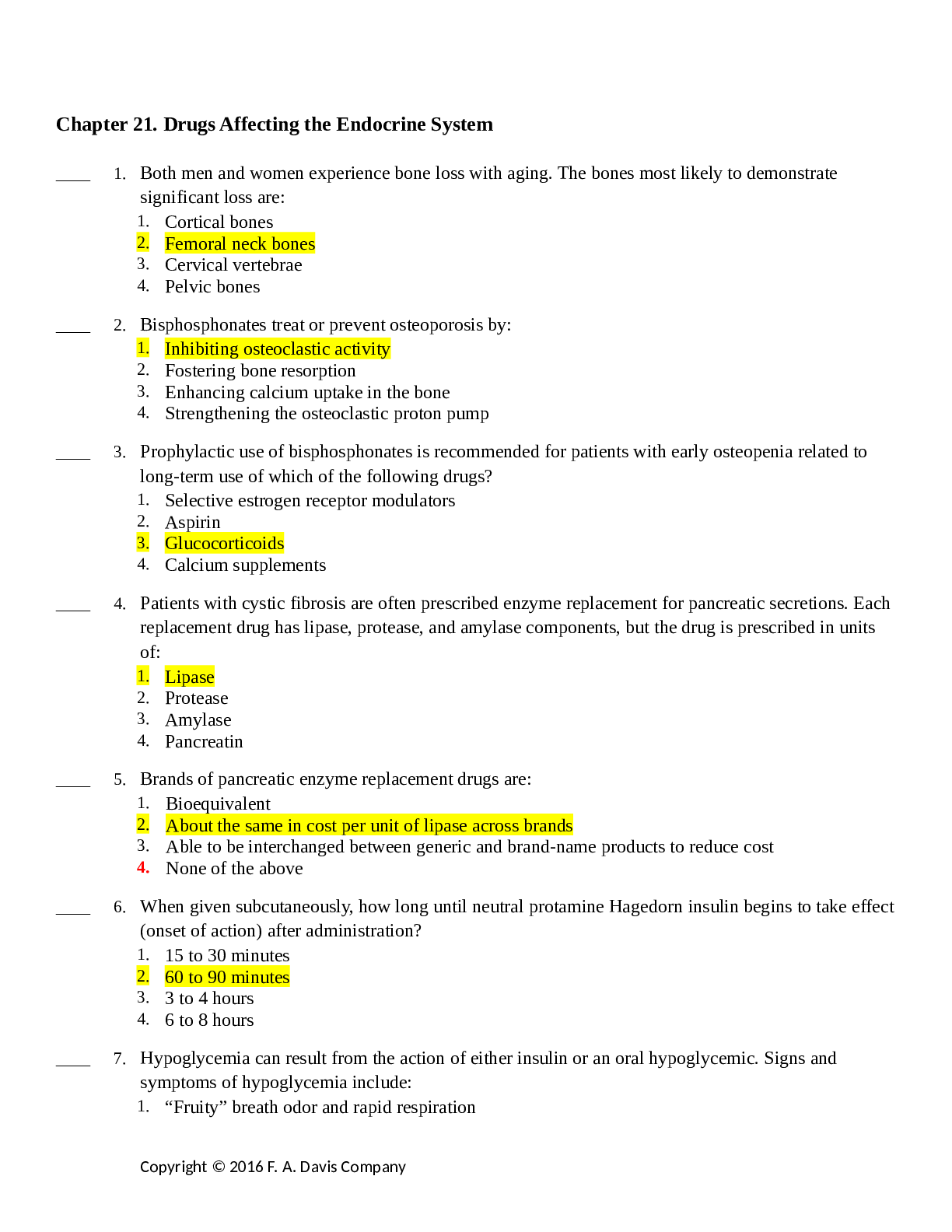
NSG6005 Week 8 Study Guide.rtf
1. Both men and women experience bone loss with aging. The bones most likely to demonstrate significant loss are: 1. Cortical bones 2. Femoral neck bones 3. Cervical vertebrae 4. Pelvic bones __...
By smiler , Uploaded: Aug 26, 2021
$14
*NURSING> QUESTIONS & ANSWERS > NSG 6020 Week 8 Study Guide (complete0 questions and answers- 2021/2022 (All)

NSG 6020 Week 8 Study Guide (complete0 questions and answers- 2021/2022
NSG 6020 Week 8 Study Guide Chapter 12. Male Reproductive System Multiple Choice Identify the choice that best completes the statement or answers the question. ____ 1. Examination of the male patient...
By A+ Grades , Uploaded: Aug 16, 2021
$15
*NURSING> QUESTIONS & ANSWERS > NSG 6020 Week 8 Study Guide (complete0 questions and answers- 2021/2022 (All)

NSG 6020 Week 8 Study Guide (complete0 questions and answers- 2021/2022
NSG 6020 Week 8 Study Guide Chapter 12. Male Reproductive System Multiple Choice Identify the choice that best completes the statement or answers the question. ____ 1. Examination of the male patient...
By Tutor Frankline , Uploaded: Aug 15, 2021
$15
Business> QUESTIONS & ANSWERS > [Solved] ACC 577 WEEK 8 STUDY (All)
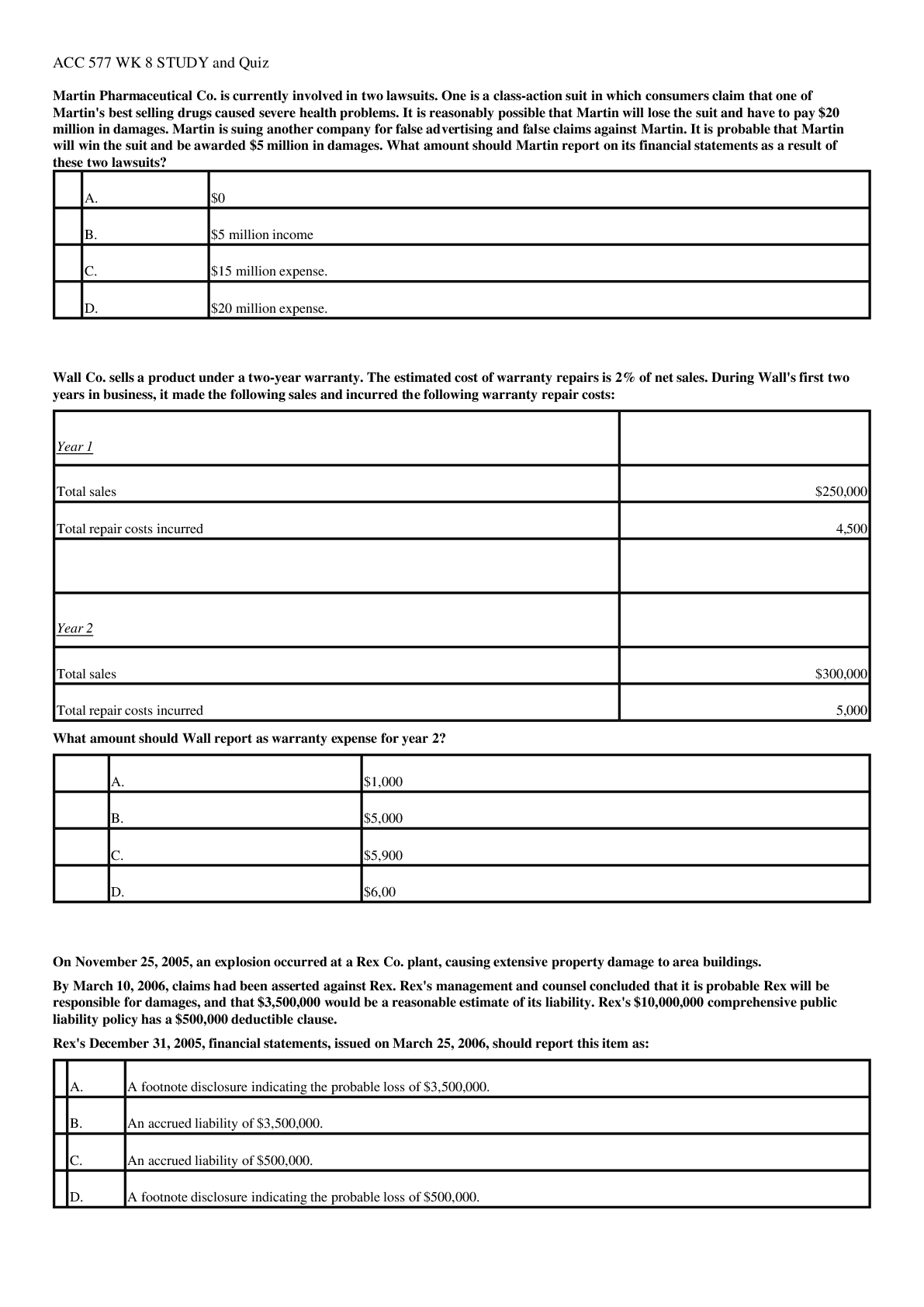
[Solved] ACC 577 WEEK 8 STUDY
ACC 577 WEEK 8 STUDY ACC 577 WK 8 STUDY and Quiz Martin Pharmaceutical Co. is currently involved in two lawsuits. One is a class-action suit in which consumers claim that one of Martin's best se...
By QUIZBANK , Uploaded: Feb 08, 2021
$7
*NURSING> QUESTIONS & ANSWERS > South University > Nursing > NSG5003 Week 8 Study guide-Renal (All)
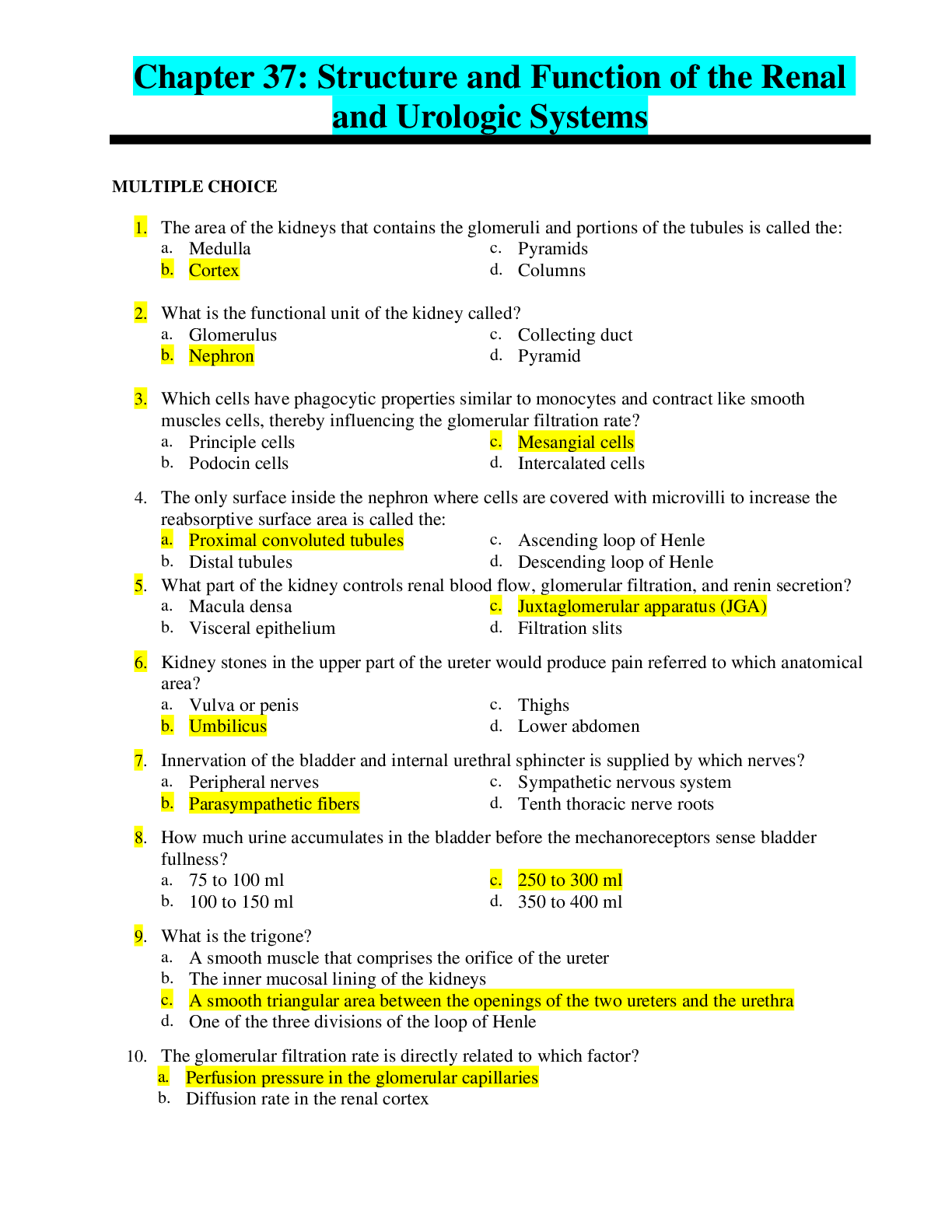
South University > Nursing > NSG5003 Week 8 Study guide-Renal
Chapter 37: Structure and Function of the Renal and Urologic Systems MULTIPLE CHOICE 1. The area of the kidneys that contains the glomeruli and portions of the tubules is called the: a. Medull...
By James , Uploaded: Apr 15, 2020
$13
*NURSING> QUESTIONS & ANSWERS > NR 511 FINAL EXAM WEEK 8 STUDY GUIDE (2022-2023) – QUESTION AND ANSWERS - Already Graded A+ (All)
 – QUESTION AND ANSWERS - Already Graded A+.png)
NR 511 FINAL EXAM WEEK 8 STUDY GUIDE (2022-2023) – QUESTION AND ANSWERS - Already Graded A+
Week 1 1. Define diagnostic reasoning a. Involves critical thinking in a way that evaluates new data to support the hypothesis and reduce alternative hypothesis. This is done by evaluating all the...
By A+ Grades , Uploaded: Nov 04, 2022
$15
*NURSING> QUESTIONS & ANSWERS > NCSBN TEST BANK for the NCLEX-RN & NCLEX-PN. Contains More than 2000 Q&A Plus Review and Rationale in 517 PAGES. (All)

NCSBN TEST BANK for the NCLEX-RN & NCLEX-PN. Contains More than 2000 Q&A Plus Review and Rationale in 517 PAGES.
NCSBN TEST BANK -for the NCLEX-RN & NCLEX-PN. Updated 2022/2023. Contains More than 2000 Q&A Plus Review and Rationale in 517 PAGES. (All Testable Questions for NCLEX-RN & NCLEX-PN)
By Expert1 , Uploaded: Jul 28, 2020
$20
Business> QUESTIONS & ANSWERS > CLM 031 EXAM (All)
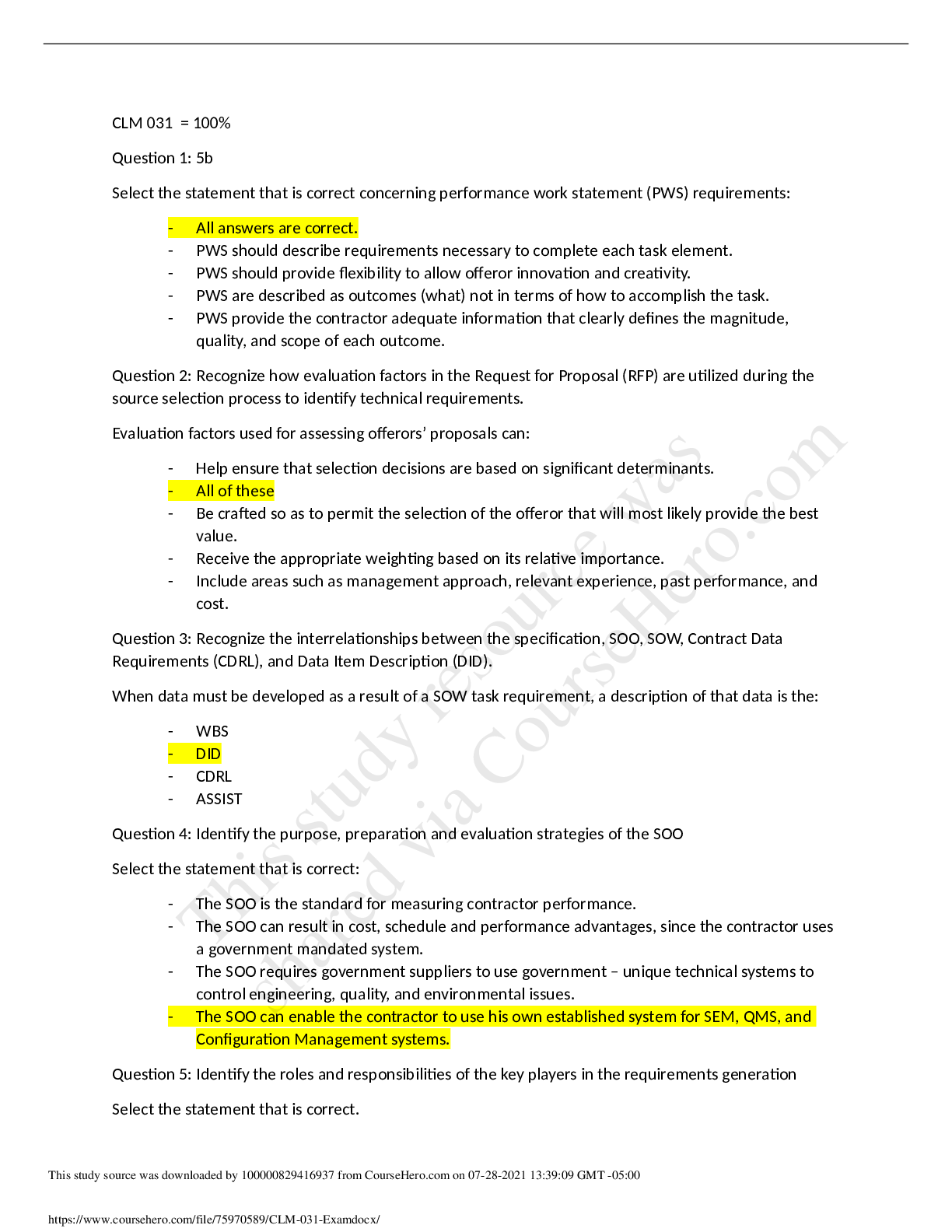
CLM 031 EXAM
CLM 031 = 100% Question 1: 5b Select the statement that is correct concerning performance work statement (PWS) requirements: - All answers are correct. - PWS should describe requirements necessary...
By Book Worm, Certified , Uploaded: Nov 03, 2022
$5
*NURSING> QUESTIONS & ANSWERS > PHIL 347 Week 6 Checkpoint Quiz. Score 100/100 (All)
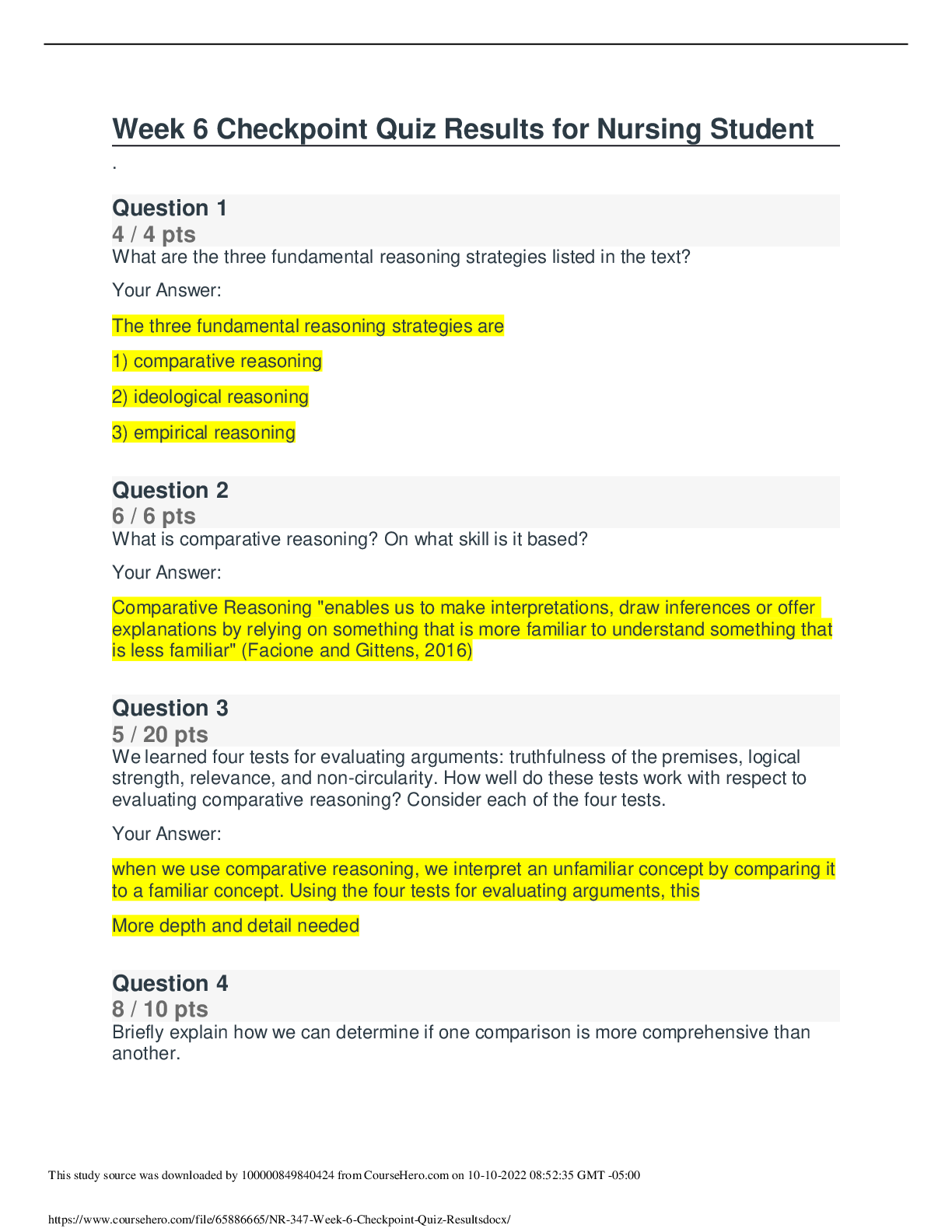
PHIL 347 Week 6 Checkpoint Quiz. Score 100/100
Question: What are the three fundamental reasoning strategies listed in the text? Question: What is comparative reasoning? On what skill is it based? Question: We learned four tests for evaluating...
By Amanda Rosales , Uploaded: Mar 24, 2021
$7
Document information
Connected school, study & course
About the document
Uploaded On
Oct 23, 2020
Number of pages
16
Written in
Additional information
This document has been written for:
Uploaded
Oct 23, 2020
Downloads
1
Views
98





